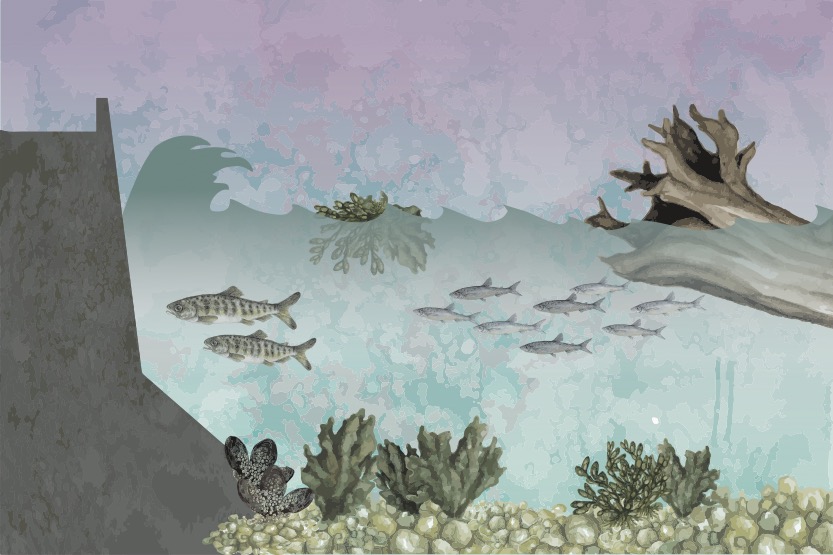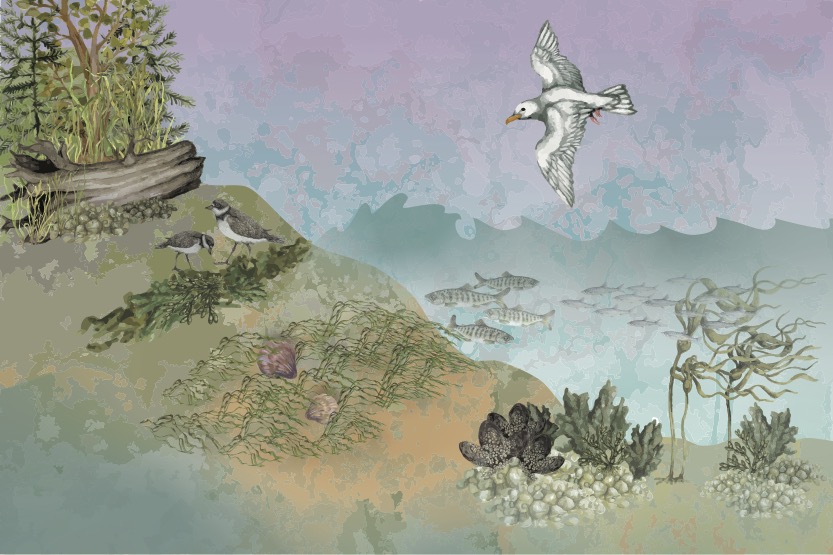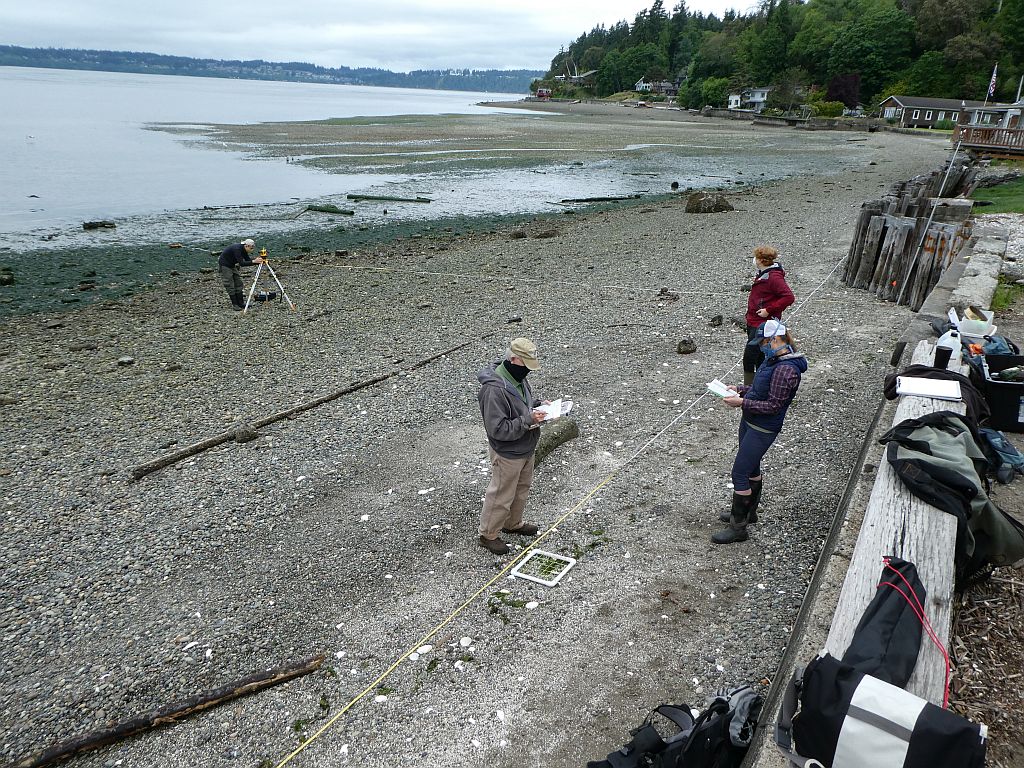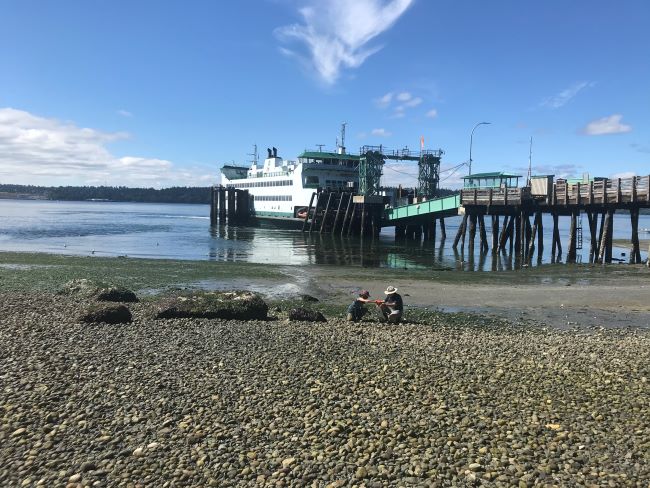Whether you live on, or visit Vashon-Maury Island, you likely know the wealth of our abundant shorelines. We have a diversity of both public and private access which allow us to visit the saltwater and shores that are at the roots of this island. Our islands’ 51 miles of shoreline are beautiful, active, and important habitats that relate deeply to the health of not just our local community but the whole of the Salish Sea.
Shorelines are important connective habitats where the terrestrial and marine world meet. The flows of sediments from beachside cliffs, for example, build some of our most iconic sandy beaches like KVI and Pt. Robinson. These sandy beaches also support eelgrass beds that provide nursery habitats for young fish and provide homes to a plethora of colorful marine invertebrates. Forage fish like Pacific herring, sand lance, and surf smelt use these sandy substrates to lay their eggs. These small fish are the first step in a complex Puget Sound food web. They eat plankton and turn it into the rich protein source of their bodies which then feed marine birds, salmon, seals, and more. In turn, these animals feed Resident and Transient Orcas. All this depends on the flow of sediment from land to sea.
But currently, ⅓ of the shoreline of the Puget Sound is armored in some way. And, according to a recent King County study, 42% of King County shorelines are armored (and almost half, 49%, of Vashon’s shorelines are armored!). Armoring not only cuts off the flow of beach building sediments, it also prevents logs and the flotsam and jetsam called beach wrack (important habitat for both terrestrial and marine invertebrates) from lodging on shore. And, as sea levels rise, bulkheads cause what scientists call the “beach squeeze”. As bulkheads jut out into the intertidal, rising sea levels are making these areas too deep for forage fish to spawn, squeezing them out. All of this means that human inhabitants of the shoreline face an increasingly complex conundrum: as sea levels rise how can shoreline properties be protected while still allowing for natural processes that sustain the Puget Sound food web?

There is no doubt that those of us who live on Vashon care about the world around us, but sometimes, especially with complex properties like those on the shoreline, we need help finding a path to stewardship. That’s where the Shore Friendly King County Program comes in. This new program, launched in 2021, aims to provide tools for shoreline homeowners across the county who want to steward their shorelines for nature’s benefit while protecting their properties. The overall Shore Friendly program is a collaborative effort happening across the Sound, but this current launch is focused on King County. Because of this, shoreline homeowners on Vashon now have easy access to consultation and tools to restore and maintain their waterfront.
What does shoreline stewardship look like? The recent removal of the bulkhead armoring at the Tahlequah Ferry Landing is one example. Here, Washington state ferries removed an old failing bulkhead, moved armoring out of the intertidal zone and back to protect the road bank, and revegetated in front of this area with native plants. They also anchored some logs in to act as habitat and soft-shore armoring in the intertidal.

Vashon Nature Center has been monitoring this restoration site along with 5 others across the island with BeachNET (Beach Nearshore Ecology Team) program volunteers to see what happens when bulkheads are removed. “One of the first things we see is a lot of erosion, it looks messy!” says Bianca Perla, Director of Vashon Nature Center, “cliffs erode, trees and vegetation get stripped away, logs crash up onto shore and stay. But, it’s nature’s way of adjusting and equilibrating. Eventually, with all that mess comes a lot of life.” When bulkheads are removed logs start anchoring on the beach providing a softer block against wave action and allowing the beach to build. Sediments start to change from rocky to sandy and the beach gets less steep which brings in forage fish like sand lance. Eventually, vegetation moves into the cleared areas and overhangs the beach providing food for juvenile salmon whose major diet consists of terrestrial insects that fall from this overhanging vegetation.
“Some changes happen very quickly and some take a long time. That’s why we keep returning to these sites and tracking what happens. We want to know how long it takes, and if things happen how we predict they will.” says Bianca. Everyone is learning together through this monitoring and that will inform how shoreline restoration is done into the future. To participate in this community science monitoring effort see Vashon Nature Center’s events page for dates and to sign up.

Jason Toft is principal research scientist in the Wetland Ecosystem Team at University of Washington, focusing on studying restoration of shorelines across Puget Sound. Toft’s lab works with Vashon Nature Center and various other groups around Puget Sound to conduct monitoring of shoreline restoration projects on over 50 sites. He was clear that shoreline restoration is something that has to happen on a large scale, “it’s bigger than just the several hundred feet of shoreline,” homeowners are looking at. But, homeowners are an important part of the overall solution. Toft and fellow research scientist Simone Des Roches are part of a key component of the collaborative team working to restore shorelines throughout the sound. “We’re all trying to work on this together,” which is no mean feat across public and private stakeholders with a variety of needs and concerns.
“Salmon are connectors across all of this work and Chinook being listed over two decades ago is what triggered it.” said Toft. “Our goals are to look at the effectiveness of restoration, monitoring sites to learn across time. Science is a process and as new information arises, we change our views.”
Monitoring change is the boilerplate of any restoration work. Maintaining and rebuilding resilient systems will be integral to tackling climate change and resulting sea level rise. Seeing dramatic change at newly restored sites like Tahlequah might be alarming or appear to signal that the work was a failure.
Greg Rabourn, Vashon Maury Island Steward and Groundwater Protection Program Manager for King County disagrees. “Removing bulkheads that have been resisting erosion for a long time can often be dramatic. When we’re done with projects, we expect change as things settle out.”
Des Roches had similar things to say. “Restoration is an active process – the point is to have things shift back into natural changes and nature is this messy system that might not always fit in with our ideas of how shorelines should look.”
While a natural shoreline is eventually a beautiful thing, Rabourn admits that bulkhead removal is not the right fit for every property owner.
“We aren’t suggesting going around the island and taking out all the bulkheads.”
However, the goal of Shore Friendly is to support restoration efforts on private land. Rabourn points out that the majority of restoration here has been on public land. “We need private property owners to participate in the Sound-wide effort,” he said.
It’s reasonable to be fearful of what might appear to be shorelines and bluffs disappearing to erosion, but Rabourn also points out that there are a variety of options a consultation with the program can suggest. These might involve “soft-armoring” in the form of anchored logs allowing for more natural processes to take place, or even planting native vegetation along the edges. Often “things that are good for slope stability are good for habitat” says Rabourn.
When asked about erosion concerns Rabourn pointed out that “Vashon has been here for twelve to fifteen thousand years – it’s not going anywhere soon.” Not only are bulkheads expensive to maintain, in some cases they aren’t even doing anything to stop erosion and leave a lot of species without access to vital habitat.
“Not all erosion is bad,” said Rabourn, “It is a natural process that builds and maintains our beaches and nearshore habitat.”
The shorelines of Vashon-Maury are ultimately diverse mixing places. “The diversity, these edges between land and sea, are probably what brought a lot of people to live on the Sound in the first place.” says Des Roches.
I know that I am often drawn to our shores to see a lot of beauty in one place, head spinning from blooming coastal flowers to shining mountain ranges, ears ringing with the peels of Pigeon Guillemots and gentle waves breaking. There’s a lot to love. And thankfully, if you live on Vashon waterfront Rabourn has a final bit of good news for folks living without armoring: “Sometimes the best thing to do is nothing.”
Click here to learn more about the Shore Friendly King County Program.


I’m happy to hear about this program, and glad that VMI residents who don’t live on beaches can learn from it too.
Will we read vignettes about tiny ecosystem communities, perhaps those tied together by fucus or blue mussels or Turkist washcloth? Or the north side of lower mid-beach boulders with barnacles, algae, dogwinkles and chitons?
I love the Simone des Roches beach illustration EXCEPT that the 45 degree angle is misleading. In fact the driftwood wouldn’t lodge on such a steep beach, nor could eelgrass establish itself. Could sand even accrete with that angle? Doesn’t the beach substrate depend a lot on the degree of slope, which also reflects the beach’s orientation to prevailing winds, fetch, currents, etc. Shouldn’t all these teaching aids reflect the real world accurately?
But this is a small criticism.
Congrats to VNC and KCDNR for assembling this program. It’s heartening.